Introduction to PC Building
Building your own PC can be a rewarding experience, offering both personal satisfaction and the opportunity to create a machine that perfectly fits your needs. Whether you're a gamer, a content creator, or just someone who appreciates the art of technology, this guide will walk you through the basics of assembling your own computer.
Understanding the Components
Before you start building, it's essential to understand the key components of a PC. Here's a quick overview:
- CPU (Central Processing Unit): The brain of your computer, responsible for executing instructions.
- Motherboard: The main circuit board that connects all components.
- RAM (Random Access Memory): Temporary storage that your CPU uses to store data for quick access.
- Storage: SSDs (Solid State Drives) and HDDs (Hard Disk Drives) store your operating system, applications, and files.
- GPU (Graphics Processing Unit): Handles rendering images, animations, and video for the computer's screen.
- PSU (Power Supply Unit): Supplies power to your computer.
- Case: Houses all your components and protects them from dust and damage.
Choosing the Right Parts
Selecting the right components is crucial for building a PC that meets your performance needs and budget. Consider what you'll be using your PC for and research each component's compatibility with others. Websites like PCPartPicker can help you ensure compatibility and find the best deals.
Step-by-Step Assembly Guide
Now that you've gathered all your components, it's time to start building. Follow these steps to assemble your PC:
- Prepare your workspace with a clean, flat surface and gather necessary tools like a screwdriver.
- Install the CPU onto the motherboard carefully, aligning the pins correctly.
- Attach the CPU cooler to keep your processor at optimal temperatures.
- Insert the RAM into the appropriate slots on the motherboard.
- Mount the motherboard inside the case, securing it with screws.
- Install the storage drives (SSD/HDD) in the designated bays.
- Place the GPU into the PCIe slot on the motherboard.
- Connect the PSU to all components, ensuring all cables are properly routed for good airflow.
- Close the case and connect your monitor, keyboard, and mouse.
Installing the Operating System
With your PC assembled, the next step is to install an operating system (OS). You can choose between Windows, Linux, or macOS (if you're using compatible hardware). Create a bootable USB drive with your chosen OS and follow the on-screen instructions to install it on your new PC.
Tips for First-Time Builders
Building a PC for the first time can be daunting, but here are some tips to make the process smoother:
- Watch tutorial videos to familiarize yourself with the assembly process.
- Handle components with care to avoid static electricity damage.
- Test your PC outside the case first to ensure all components work.
- Keep your workspace organized to avoid losing small screws or parts.
Conclusion
Building your own PC is an exciting journey that not only saves you money but also gives you a deeper understanding of how computers work. With the right preparation and patience, anyone can assemble their own custom PC. Remember, the key to a successful build is research, careful component selection, and attention to detail during assembly.
